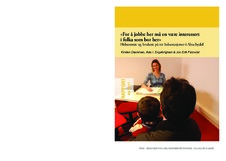"For å jobbe her må en være interessert i folka som bor her"
Report

Åpne
Permanent lenke
https://hdl.handle.net/20.500.12199/3369Utgivelsesdato
2011Metadata
Vis full innførselSamlinger
- NIBR notat [1018]
Sammendrag
To work actively, in a targeted, planned manner to promote equality and prevent discrimination is an explicit objective for Norwegian authorities. To develop equal, non-discriminatory public services is an essential part of this work. The principal task of The Equality and Anti-discrimination ombud is to guide the public as well as government and private agencies on how to fulfil this objective. In 2010 the ombud worked specifically to raise awareness among authorities and public service institutions on how to offer equal services to all, irrespective of ethnicity, religion, gender, ability to function, age and sexual orientation. The present report was commissioned by The Equality and Anti-discrimination ombud. The research problem was to study whether and how the child welfare system in the municipality of Alna in Oslo provided equal and non-discriminatory services to all categories that are included in the anti-discriminatory acts. The research comprised four person months and consisted of interviews with public health nurses in three child welfare centres and parents in two open kindergartens, a short survey to parents visiting the centres and kindergartens and a survey to youths about the public health service in schools. Child Welfare centres are public health centres for families and for children and youth up to the age of 23. Alna is one of the most multicultural municipalities in Norway with 45% immigrants or children of immigrants, so ethnicity became the core issue of the study. According to our informants, questions of discrimination based on religion, ability to function and sexual orientation was not relevant because such clients were extremely rare. The focus among nurses and parents in the study was on ethnic discrimination or unequal services based on ethnicity and gender; this concern was consistent across both majority and minority groups. Our findings are presented in terms of Structural, Organisational and Cultural factors that hinder the development of equal services. Nancy Frazer’s concepts distribution, recognition and representation are employed to assess the degree of equality of services.@ Structural barriers that may hinder equal services were found to be: Staff at child welfare centres do not represent the population they serve as almost all are native Norwegians without physical disabilities or other minority characteristics. We found that the formal competence in handling diversity among nurses is almost non-existing. We also found that too many tasks and too little time to perform them combined with many non- Norwegian- speaking clients, undersized budgets and no priority given to use interpreters. may hinder equal treatment. Organisational barriers were found to be: Services to children in school appeared to have limited availability due to a practice where children had to ask for leave to visit the public nurse. This may hinder children with ethnic backgrounds or with functional disabilities to reveal their vulnerability in class. Most consultations at child welfare centres are arranged as group consultations; individual consultations have to be specially asked for. This may be a hindrance for non-Norwegian clients and clients that want more privacy to receive the service they need. Most information brochures at the centres are available only in Norwegian, thus important information is often unavailable to non-Norwegian speakers. Tests used to assess the language skills and cognitive development of children are given in Norwegian only. Children with little competence in Norwegian are thus not tested equally to native speakers. Cultural barriers were found to be: Advice from nurses to parents were generally based on Norwegian "official" concepts of family. Cultural differences concerning child rearing practices and concepts concerning relationships between parents and children, were often difficult to follow, not only for many minority parents, but for many native parents as well. Advice was often not based on the actual diversity that exists among clients. Nurses reported experiencing tension between giving practical, "official" advice and being client-oriented and more culturally sensitive. Child welfare centres in the municipality of Alna are generally providing equal and non-discriminatory services to the population, but their ability to do this is restricted by some structural, organisational and cultural barriers that should be discussed and removed. Et likeverdig tjenestetilbud til alle, uansett etnisitet, kjønn, religion, funksjonsevne, alder og seksuell orientering, er en uttalt politisk målsetting. Hvordan realiseres denne målsettingen i praksis? For å svare på dette har NOVA gjennomført en datainnsamling om helsestasjonstilbudet i bydel Alna. Studien omfatter intervju med ansatte og foreldre på tre helsestasjoner og en kort spørreundersøkelse rettet mot foreldre og ungdom på skolene. Studien viser at det kun er etnisitet som oppfattes som etdiskrimineringsgrunnlag i bydelen, både blant ansatte og foreldre. Ansatte ser imidlertid ut til å håndtere dette mangfoldet på en ikke-diskriminerende måte. Vi fant imidlertid flere strukturelle og organisasjonsmessige forhold som kan hindre utførelsen av et likeverdig tjenestetilbud, og at kulturelle forskjeller mellom foreldres og helsestasjonenes sosialiseringsnormer kan føre til frustrasjoner hos begge parter.